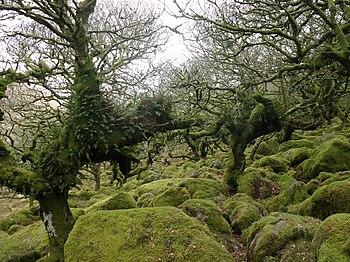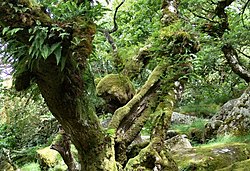Wistman's Wood

Wistman's Wood is a remarkable, unearthly woodland on the high moors of Dartmoor in Devon, covering some nine acres above a lonely stretch of the East Dart River.
Here a woodland of stunted, twisted and gnarled oak trees, laden with moss and parasitic plants, grows on a steep valley side made up of huge granite boulders, through which the trees have forced their way.
These are not mighty oaks; even the oldest trees stand at perhaps twenty feet high on average, their development hindered by the cruel ground in which they attempt to grow, where roots can find little purchase. The result is an oak forest in miniature, a pygmy forest, where the tumbled valley boulders are presented beneath a close canopy of green, twisted oak, moss and lichen.
The wood is to be found of the east side of the valley of East Dart, on the side of a hill the north of Two Bridges. It is one of only three remote high-altitude oakwoods on Dartmoor; the other two being at Black Tor Beare on the West Okement and Piles Copse on the River Erme.
Geography
The wood lies at an altitude of 1,250 feet to 1,350 feet in the East Dart's valley.[1] at grid reference SX612774.
The source of the Devonport Leat, at a weir on the West Dart River, is just north of the wood.
The wood is split into three main blocks (North, Middle and South Groves or Woods), which in total cover about nine acres.[1] These occupy sheltered, south-west facing slopes, where a bank of large granite boulders (known as "clitter") is exposed, and pockets of acid, free-draining, brown earth soils have accumulated.
The trees are mainly pedunculate oak, with occasional rowan, and a very few holly, hawthorn, hazel, and eared-willow. Tree branches are characteristically festooned with a variety of epiphytic mosses and lichens and, sometimes, by grazing-sensitive species such as bilberry (Vaccinium myrtillus) and polypody (Polypodium vulgare).

On the ground, boulders are usually covered by lichens and mossy patches – frequent species include Dicranum scoparium, Hypotrachyna laevigata, Rhytidiadelphus loreus and Sphaerophorus globosus – and, where soil has accumulated, patches of acid grassland grow with heath bedstraw (Galium saxatile), tormentil (Potentilla erecta) and sorrel (Rumex acetosa)
In places protected from livestock, grazing-sensitive plants such as wood sorrel (Oxalis acetosella), bilberry, wood rush (Luzula sylvatica) and bramble (Rubus fruticosus) occur. A fringe of bracken surrounds much of the wood, demarcating the extent of brown earth soils.[1]
The wood is home to a large population of adders (Vipera berus).[1]
Conservation status
Wistman's Wood is owned by the Duchy of Cornwall[1] and has been managed since 1961 under a nature reserve agreement with the Nature Conservancy Council, English Nature and Natural England. There is no active management, but many people visit the site on foot (mostly accessing the southern end of South Wood), and cattle and sheep have free access where the terrain permits, outside of a small fenced exclosure in South Wood.
This is one of the highest oakwoods in Britain and, as an outstanding example of native upland oak woodland, was selected as a 'Site of Special Scientific Interest' in 1964.[2] It is also a 'Nature Conservation Review site' and forms part of the Wistman’s Wood National Nature Reserve.
The wood was also one of the primary reasons for selection of the 'Dartmoor Special Area of Conservation'.[3]
History
Wistman's Wood has been mentioned in writing for hundreds of years. It is likely a left-over from the ancient forest that covered much of Dartmoor c. 7000 BC, before Mesolithic hunter/gatherers cleared it after around 5000 BC.[1]
Photographic and other records show that Wistman's Wood has changed considerably since the mid-19th century; at the same time climatic conditions have also generally become warmer.[4][5] Not only have the older oak trees grown from a stunted/semi-prostrate to a more ascending form, but a new generation of mostly straight-grown and single-stemmed oaks has developed.
The oldest oaks appear to be 400–500 years old, and originated within a degenerating oakwood that survived in scrub form during two centuries of cold climate.[1] In c. 1620 these old trees were described as "no taller than a man may touch to top with his head". Tree height increased somewhat by the mid-19th century, and during the 20th century approximately doubled (in 1997 the maximum and average height of trees was around 40 feet and 23 feet respectively).[5] In addition, a wave of marginal new oaks arose after c. 1900, roughly doubling the area of wood.
Part of the evidence for these changes comes from a permanent vegetation plot located in the southern end of South Wood. This is the oldest known of its kind in British woodland, with a small part having been recorded by Hansford Worth in 1921.[6]
The Buller Stone, a boulder to the east of the wood, commemorates an attempt in 1866 to date the trees, when Wentworth Buller (with permission from the Duchy) felled an oak. It was estimated to be 168 years old.[1]
Myths, art and literature
The wood has been the inspiration for numerous artists, poets, photographers and appears in hundreds of nineteenth century accounts. One tradition holds that it was planted by Isabella de Fortibus (1237-93).[1]
The wood is described in detail and discussed as a point of great interest in The Tree, a 1978 essay on naturalism by English novelist John Fowles.
The name of Wistman's Wood may derive from the dialect word 'wisht' meaning 'eerie/uncanny',[7] or ‘pixie-led/haunted’.[8]
The legendary Wild Hunt in Devon is particularly associated with Wistman's Wood – the hellhounds of which are known as Yeth (Heath) or Wisht Hounds in the Devonshire dialect.[9]
Outside links
| ("Wikimedia Commons" has material about Wistman's Wood) |
- Location map: 50°34’37"N, 3°57’40"W
- OS map: SX612774
References
- ↑ 1.0 1.1 1.2 1.3 1.4 1.5 1.6 1.7 1.8 Wilson, Matthew (19 June 2015). "Twisted oaks and tales on the trail of Devon's pygmy forest". Financial Times. http://www.ft.com/cms/s/0/654b7294-0f84-11e5-b968-00144feabdc0.html. Retrieved 3 March 2016.
- ↑ SSSI listing and designation for Wistman's Wood
- ↑ Dartmoor SAC
- ↑ Proctor, M.C.F., Spooner, G.M. and Spooner, M.: 'Changes in Wistman’s Wood, Devon: photographic and other evidence': Transactions of the Devonshire Association for the Advancement of Science Volume 112, 1980; Pages 43-79.
- ↑ 5.0 5.1 Mountford, E,P., Backmeroff, C.E. and Peterken, G.F.: ' Long-term patterns of growth, mortality, regeneration and natural disturbance in Wistman’s Wood, a high altitude oakwood on Dartmoor'. Transactions of the Devonshire Association for the Advancement of Science Volume 133, 2001; Pages 231-262.
- ↑ Christy, M. and Worth, R.H.: 'The ancient dwarfed oak woods of Dartmoor'. Transactions of the Devonshire Association for the Advancement of Science Volume 54, 1922; Pages 291-342.
- ↑ Westwood, Jennifer: 'Albion. A Guide to Legendary Britain' (Grafton Books, 1985) ISBN 0-246-11789-3, page 32
- ↑ Eric Hemery (1983). High Dartmoor. London: Robert Hale. pp. 454–455. ISBN 0-7091-8859-5.
- ↑ Westwood, Jennifer: 'Albion. A Guide to Legendary Britain' (Grafton Books, 1985) ISBN 0-246-11789-3, pages 155 - 156.
- Worth, R. N.: 'Worth's Dartmoor'(David & Charles, 1967) pages 74-83, ISBN 0715351486
